Took a friend to the Grand Ideas Garden after the bakery this morning. She stirred up a cloud of shy monarchs so I could try to capture them on film. When we approached, they were fluttering about these sunflowers enjoying the nectar. What a lovely site.
Category Archives: pollinators
Monarch Release Party
Today the Other Half and I visited the zoo for the annual Monarch Day. Each fall between September and November, monarch butterflies (Danaus plexippus) migrate from our state all the way down to Oyamel fir (Abies religiosa) forests in Mexico. Here’s a migration map from the zoo’s monarch butterfly house display.
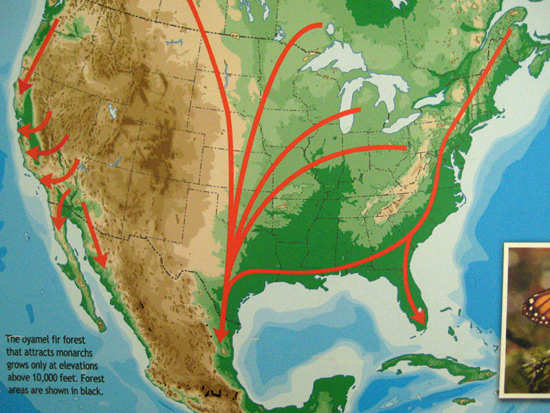
At this educational event for the public, monarchs are tagged with a small sticker on the underside of their wings and released to begin their migration. This coming spring, those who released the monarchs can check for their butterfly’s number through Journey North. This project relies on citizens to report their sightings of monarchs, creating an overall snapshot of the butterflies’ journey.
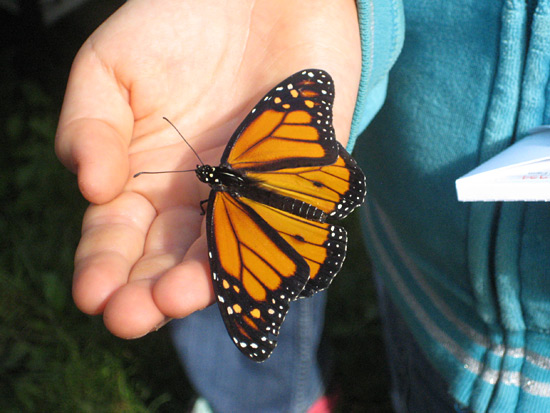
Since Wednesday, the weather has been blessedly cooler than the previous week. This made for some lazy butterflies. They hung around the crowd, orienting themselves and taking in some sun. This little one perched above us in a maple for a bit.
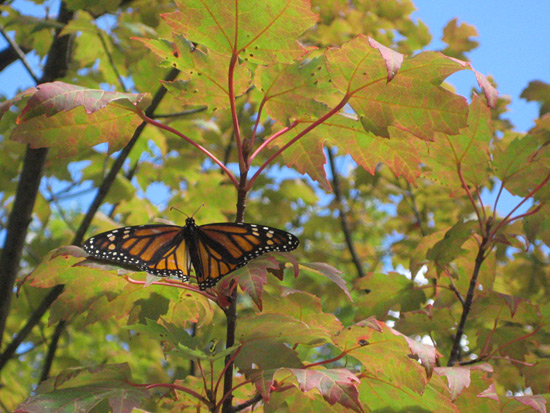
Some of the butterflies wandered over to the pollinator garden on the hillside beside the gathering of people. I was able to get close enough to this one I could see it turning its head from side to side.
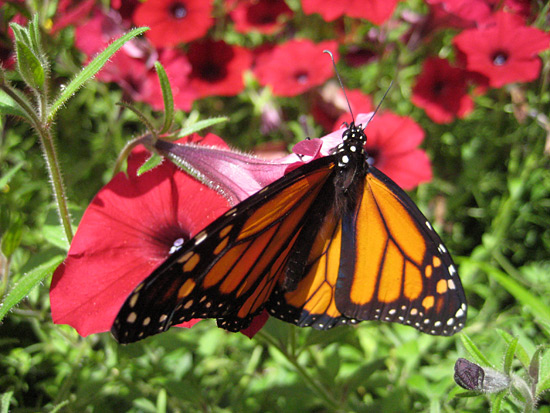
Loss of habitat and pesticides have both contributed to the decline of the monarch butterfly. Though the monarchs enjoy nectar from many different flowers, they will only lay their eggs on the milkweed plant since that is the only food the larvae will eat.
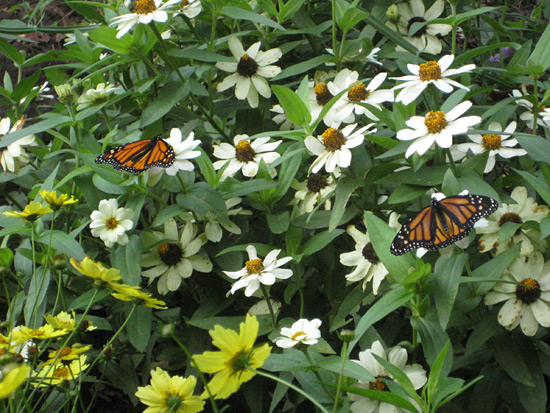
How to Help Monarchs
On the Lot we have both swamp milkweed (Asclepias incarnata) and common milkweed (Asclepias syriaca) planted. Next season we plan to add buttefly weed (Asclepias tuberosa). Planting milkweed and having several pollinator-friendly nectar sources is a great way to get started on helping monarch butterflies.
Buyer Beware
However, be wary on where you purchase the milkweed for your garden. I was upset upon hearing a radio report this past May about systemic insecticides called neonicitinoids being used on milkweed. Customers purchase these plants at large box stores and then end up poisoning the monarch larvae they are trying to help.
The director of Monarch Watch at the University of Kansas, Chip Taylor instructs “Go to a native plant nursery and quiz the manager of the nursery about the use of systemics. And if they can assure you they don’t use any systemics, then buy the plants from them.”
More Monarch Resources
Milkweed Seed Finder (provided by the Xerces Society)
Corner Garden Creation
During a recent extended family fishing trip, Mom and Dad L chatted with me about wanting to revive bits of their backyard landscape. Being globetrotters and full-time grandparents, these two had handed over the management of the area to nature. Now they wanted to introduce a bit more order and color, but still provide pollinators and birds with food.
The Site
The little, sunny area they had their eye on sits at the southeast edge of their urban, corner lot. Viewers would see the flower bed from the sidewalk, the backyard, and from within the house at the kitchen window. That section of the backyard had been overrun by bull thistle (Cirsium vulgare) for several years, so the plants had built up quite the dense colony. The soil was also heavily compacted, so it was tilled and a lot of compost was worked into the bed to begin restoring structure to the soil. Good soil structure allows water to drain down through the soil and gives plants the ability to stretch out those roots without hinderance.
The Plants
When making suggestions for the new bed, I wanted to make sure the plants:
- were magnets for birds, bees, and butterflies
- were tough and didn’t require much maintenance beyond their first year
- were colorful through different parts of the season
- were sizes from very tall (seen from the house) to shorter (seen from the edges of the bed)
Final Plant Selection for a Sunny Bed
Here is the final roundup to begin with for this bed, in the order of bloom time. The blooming period of the plants overlap each other so there is always more than one plant in bloom at once. Some of these plants were volunteers from The Lot (it’s a great way to thin out overcrowded beds in your own garden) and some were already in Mom and Dad L.’s backyard.
- Existing Random Tulips
- 3 Bee Balm (Monarda)
- 2 Butterfly Weed (Asclepias tuberosa)
- 3 Asiatic Lilies
- 3 Hybrid Tea Roses
- 5 Daylilies
- 2 Russian Sage (Perovskia atriplicifolia)
- 5 Purple Coneflowers (Echinacea purpurea)
- 3 Black-eyed Susan (Rudbeckia hirta)
- 3 Sedum
The Placement
Stepping stones and plants were placed in the bed. We didn’t plant right away to allow for an adequate amount of shuffling, changing our minds, and reorganizing yet again. The stones allow Mom and Dad L. a way to access the plants without stepping directly onto the bed and compacting the soil again. Here is the preliminary layout for the flower bed as it is view directly from the backyard.
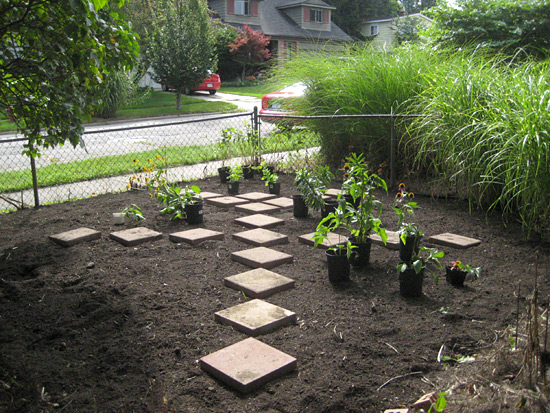
Here is the same bed viewed from the sidewalk at the edge of the property. The roses were placed at the edges of the bed and not next to the path where a gardener would get scratched up. The coneflowers at the back will provide a tall backdrop for the bed.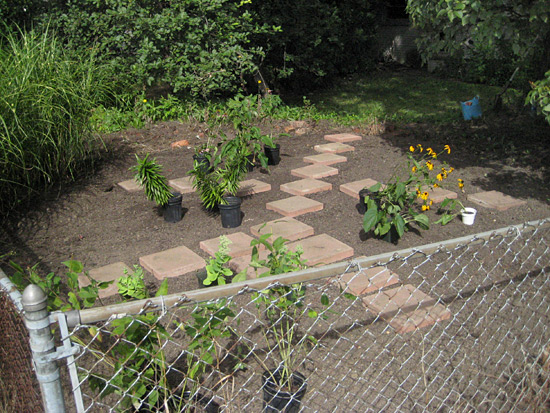
And here is the bed once again, this time viewed across the backyard from the kitchen window. That same backdrop of purple coneflowers will create a large enough stand to be admired from this angle as well.
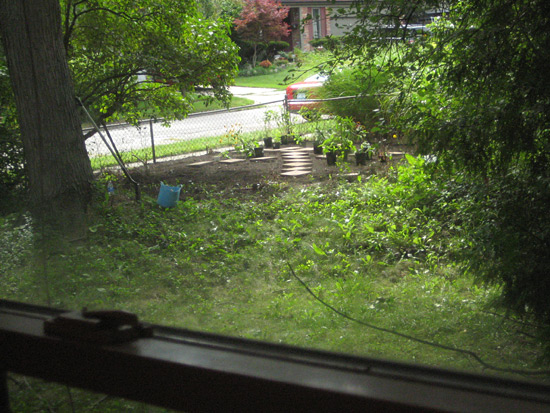
Finally we planted and watered the plants into the bed.
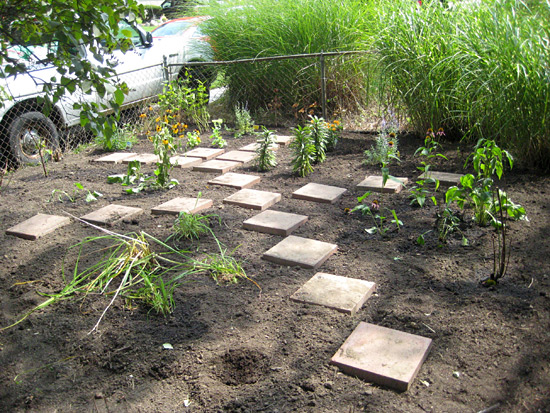
Finishing Touches
To help keep moisture in the soil for the new plants and block sunlight from the thistles more than likely beneath surface, we mulched the bed. Cypress mulch was applied 3 inches thick throughout, even under the stepping stones. Here is the finished bed from the backyard.
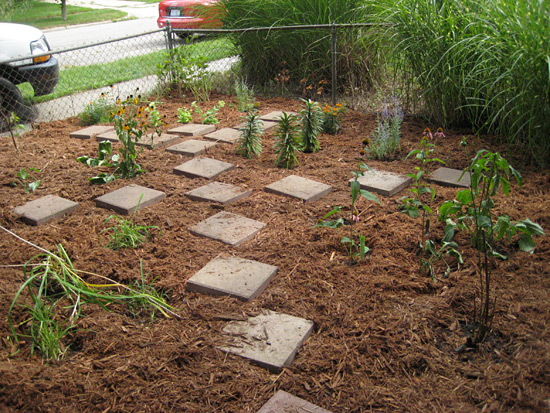
And here it is from the sidewalk. 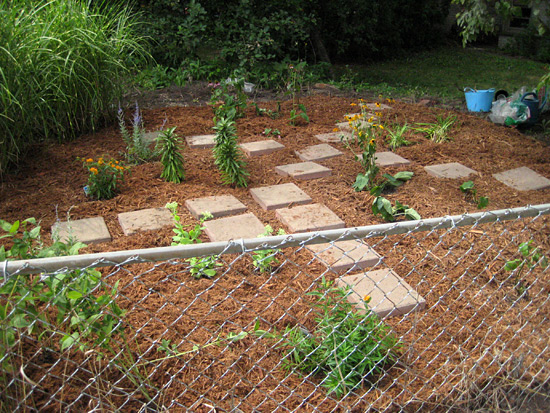
It was really, really, REALLY hard for me not to place the plants closer together. However, I had learned it is better to allow the plants room to grow toward each other over the years rather than on top of each other during the second season.
Hopefully our winter is kind to the garden and all these transplants make it through to spring. In our Zone 6, if we plant by the end of summer, fall allows an adequate amount of time for the plants to settle in before the snow flies. I’m excited to see this bed next spring.